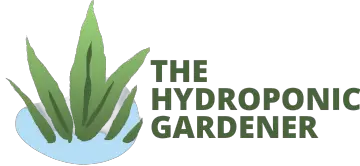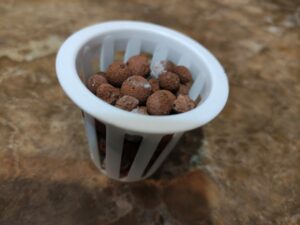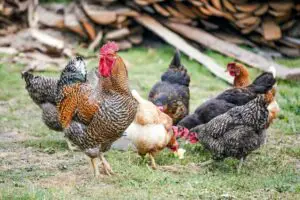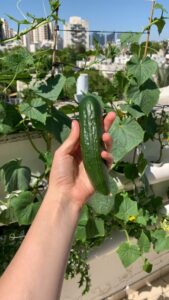If you are just starting out with hydroponics, you may be wondering how to use clay pebbles for the first time. Clay pebbles are a popular growing medium among gardeners. You may know them from growing succulants and aquarium wash
They are lightweight, porous balls and have a large surface area that allows for excellent oxygenation and drainage. In this blog post, I will teach you everything you need to know about using expanded clay pebbles in your hydroponic system!
TL;DR
Clay pebbles are a popular choice for hydroponic gardening, thanks to their high porosity, large surface area, and excellent oxygenation and drainage. To use clay pebbles in your garden for the first time, you simply rinse them thoroughly and add them to your planting bed or nutrient reservoir. In order to care for your clay pebbles and get the most out of them, you should also regularly rinse, inspect, and replenish their nutrients as needed. With proper care and maintenance, clay pebbles can help you grow healthy, thriving plants in your hydroponic garden.
What are clay pebbles and how do they work in hydroponic gardens?
Clay pebbles are small, porous pieces of clay that are commonly used as a growing medium in hydroponic gardens. They are also called Hydropton and Leca.
They are neutral ground, meant to hold the place in place. not affecting the pH of the water.
Due to their high porosity and large surface area, they provide excellent oxygenation and drainage for plants, making them an ideal choice for hydroponic growers.
To use clay pebbles in your garden, simply add them to a planting bed or nutrient reservoir, along with any other growing media of your choice. You can also use them in conjunction with other hydroponic systems, such as aquaponics or ebb and flow systems.
How do you prepare your clay pebbles for use in a hydroponic garden?
To prepare your clay pebbles for use in a hydroponic garden, it is important to rinse them thoroughly and inspect them for any debris or foreign objects. You may also want to soak the clay pebbles in water overnight, which can help to further loosen up any clumps or compacted particles.
Once your clay pebbles are ready to go, you can either add them directly to your hydroponic system or use them as a growing medium in a planting bed. Some growers also choose to mix clay pebbles with other media such as perlite, coco coir, or vermiculite for additional support and aeration.
Do you have to soak clay pebbles before first use?
There is no set rule for how to use clay pebbles in hydroponic systems, as different growers may have different preferences when it comes to preparing and using these materials.
However, most growers recommend soaking the clay pebbles overnight before first use, as this can help loosen up any clumps or compacted particles.
How do you plant your seeds or seedlings in your clay pebbles?
When planting your seeds or seedlings in your clay pebbles, it is important to create a well-draining growing medium with good aeration. To do this, simply add your clay pebbles to the hydroponic system or planting bed of your choice and mix in some additional media such as perlite or coco coir.
You may also want to consider using a propagation dome or other type of seedling tray for optimal germination and growth. This can help to ensure that your seedlings receive the adequate moisture, heat, and light they need to thrive in your hydroponic garden.
How do you care for your clay pebbles?
To care for your clay pebbles, it is important to keep them clean at all times. This is an article about cleaning clay pebbles.
Cleaning can be done by regularly rinsing the pebbles with water and inspecting them for any signs of debris or foreign objects.
Additionally, you may want to periodically replenish any nutrients that have been depleted from the clay pebbles over time.
what common problems might you encounter with clay pebbles?
One potential problem that you may encounter with clay pebbles is nutrient depletion over time. To avoid this, it is important to regularly replace the nutrients in your hydroponic system and perform regular maintenance on your growing media.
Quick answers about clay pebbles:
Do clay pebbles float?
No. Even though they are light, they are made of clay. This material is too heavy to float.
Are hydroponic clay pebbles reusable?
Yes, hydroponic clay pebbles are reusable and can be used over and over again in your garden. They can be cleaned with a light scrubbing or rinsed thoroughly to remove any stubborn residues, or just soak in water.
Do clay pebbles change pH?
Nope, clay pebbles don’t change the water’s pH.
Do clay pebbles attract bugs?
The short answer is no. The thing attracting bugs is the plant and the soil, not the pebbles. Plants do attract bugs, but hydroponically grown plants attract fewer bugs than plants grown in soil. So the long answer is “no, but the plants do – and hydroponics attract fewer plants than soil“
Conclusion:
Clay pebbles are an ideal choice for hydroponic gardeners, thanks to their high porosity, large surface area, and excellent oxygenation and drainage. To use clay pebbles in your garden – for the first time and generally – simply rinse them thoroughly and add them to your planting bed or nutrient reservoir. When planting your seeds or seedlings in your clay pebbles, it is important to create a well-draining growing medium and provide your plants with the moisture, heat, and light they need for optimal growth. Additionally, you will need to care for your clay pebbles by regularly rinsing, inspecting, and replenishing their nutrients as needed. With proper care and maintenance, clay pebbles can help you grow healthy, thriving plants in your hydroponic garden.
If you are just starting out with hydroponics, you may be wondering how to use clay pebbles for the first time. Clay pebbles are a popular growing medium among hydroponic gardeners and for good reason! They are lightweight, porous, and have a large surface area that allows for excellent oxygenation and drainage. In this blog post, we will teach you everything you need to know about using clay pebbles in your hydroponic garden!
What are clay pebbles and how do they work in hydroponic gardens?
Clay pebbles are small, porous pieces of clay that are commonly used as a growing medium in hydroponic gardens. They are also called Hydropton and Leca.
They are neutral ground, meant to hold the place it place. not affecting the pH of the water.
Due to their high porosity and large surface area, they provide excellent oxygenation and drainage for plants, making them an ideal choice for hydroponic growers.
To use clay pebbles in your garden, simply add them to a planting bed or nutrient reservoir, along with any other growing media of your choice. You can also use clay pebbles in conjunction with other hydroponic systems, such as aquaponics or ebb and flow systems.
With proper care and maintenance, clay pebbles can help you grow healthy, thriving plants in your hydroponic garden.
How do you prepare your clay pebbles for use in a hydroponic garden?
To prepare your clay pebbles for use in a hydroponic garden, it is important to rinse them thoroughly and inspect them for any debris or foreign objects. You may also want to soak the clay pebbles in water overnight, which can help to further loosen up any clumps or compacted particles.
Once your clay pebbles are ready to go, you can either add them directly to your hydroponic system or use them as a growing medium in a planting bed. Some growers also choose to mix clay pebbles with other media such as perlite, coco coir, or vermiculite for additional support and aeration.
Do you have to soak clay pebbles before first use?
There is no set rule for how to use clay pebbles in hydroponic systems, as different growers may have different preferences when it comes to preparing and using these materials.
However, most growers recommend soaking the clay pebbles overnight before first use, as this can help loosen up any clumps or compacted particles.
How do you plant your seeds or seedlings in your clay pebbles?
When planting your seeds or seedlings in your clay pebbles, it is important to create a well-draining growing medium with good aeration. To do this, simply add your clay pebbles to the hydroponic system or planting bed of your choice and mix in some additional media such as perlite or coco coir.
You may also want to consider using a propagation dome or other type of seedling tray for optimal germination and growth. This can help to ensure that your seedlings receive the adequate moisture, heat, and light they need to thrive in your hydroponic garden.
How do you care for your clay pebbles?
To care for your clay pebbles, it is important to keep them clean at all times. This is an article about cleaning clay pebbles.
Cleaning can be done by regularly rinsing the pebbles with water and inspecting them for any signs of debris or foreign objects.
Additionally, you may want to periodically replenish any nutrients that have been depleted from the clay pebbles over time.
what common problems might you encounter with clay pebbles?
One potential problem that you may encounter with clay pebbles is nutrient depletion over time. To avoid this, it is important to regularly replace the nutrients in your hydroponic system and perform regular maintenance on your growing media.
Quick answers about clay pebbles:
Do clay pebbles float?
No. Even though they are light, they are made of clay. This material is too heavy to float.
Are hydroponic clay pebbles reusable?
Yes, hydroponic clay pebbles are reusable and can be used over and over again in your garden. They can be cleaned with a light scrubbing or rinsed thoroughly to remove any stubborn residues, or just soak in water.
Do clay pebbles change pH?
Nope, clay pebbles don’t change the water’s pH.
Do clay pebbles attract bugs?
The short answer is no. The thing attracting bugs is the plant and the soil, not the pebbles. Plants do attract bugs, but hydroponically grown plants attract fewer bugs than plants grown in soil. So the long answer is “no, but the plants do – and hydroponics attract fewer plants than soil“
Conclusion:
Clay pebbles are an ideal choice for hydroponic gardeners, thanks to their high porosity, large surface area, and excellent oxygenation and drainage. To use clay pebbles in your garden – for the first time and generally – simply rinse them thoroughly and add them to your planting bed or nutrient reservoir. When planting your seeds or seedlings in your clay pebbles, it is important to create a well-draining growing medium and provide your plants with the moisture, heat, and light they need for optimal growth. Additionally, you will need to care for your clay pebbles by regularly rinsing, inspecting, and replenishing their nutrients as needed. With proper care and maintenance, clay pebbles can help you grow healthy, thriving plants in your hydroponic garden.
FAQ
You don’t have to, but you may want to wash the pebbles before the first use, to make sure they are clean.
Clay pebbles do not float, as they are made of a heavy clay material that is too dense to float. This means that they can be used effectively in hydroponic gardening systems, where good water drainage and aeration are essential for healthy plant growth.
Yes, hydroponic clay pebbles can be reused multiple times in your garden. To clean them, you can rinse them with water or scrub them lightly to remove any debris or buildup.
Yes, hydroponic clay pebbles can be reused multiple times in your garden. To clean them, you can rinse them with water or scrub them lightly to remove any debris or buildup.






